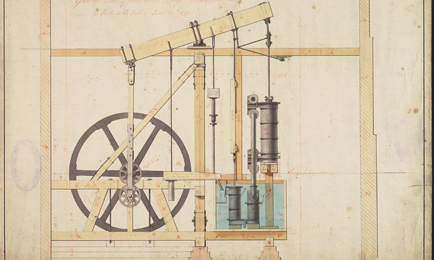Articles
The son of a Birmingham manufacturer of small metal products, Matthew Boulton managed the family business during the 1750s and 1760s; expanding operations at its Soho Manufactory. Some of his success was due to using modern manufacturing techniques which helped efficiency and production; and meant he could widen his product range into decorative metals.
At the time, Scottish engineer James Watt was partnered to John Roebuck who owed a £1,200 debt to Boulton – the equivalent of £102,000 today. In order to pay it off, Boulton accepted Roebuck’s two-third share of Watt’s first steam-engine patent.
Due to be released from the protection of patent, Boulton successfully lobbied parliament to extend it for 17 years until 1800. This enabled the firm to market Watt’s engine as the Boulton & Watt and subsequently corner the market.
Prior to them becoming partners, Boulton had known about Watt and his invention – he needed a solution to his hydropower limitations at Soho and recognised that Watt’s engine could provide this, so he accepted the patent. Boulton convinced Watt to move to Birmingham and employed iron master John Wilkinson to help get the engine ready for market. Eventually, engines were sold all over the world.
After this breakthrough, Boulton also undertook many other successful ventures. Among these was the production of coinage. By 1786, it was estimated that two thirds of silver and copper coinage in circulation was counterfeit. Between 1773 and 1821 the Royal Mint produced no copper coins at all. In response, copper tokens roughly
the size of a halfpenny were struck on behalf of merchants and Boulton made millions of them.
In 1788 he founded the Soho Mint as Boulton held shares in Cornish copper mines and owned a stockpile of copper. The mint soon took off, with an order to strike coins for the British East India Company.
Boulton lobbied for a contract to strike British coins, but in June 1790 the government postponed a decision on recoinage indefinitely. Meanwhile, the mint struck coins for Sierra Leone and Russia, while producing high-quality planchets (blank coins) to be struck by national mints elsewhere.

Hot water: Due to John Roebuck owing him a debt, Boulton gained a two-third share of Watt’s first steam-engine patent
Privately, Boulton was an enthusiastic amateur scientist, being a key member of the Birmingham-based arts, theology and science discussion and experimental group – The Lunar Society. Other members included ceramicist Josiah Wedgwood and James Watt. Boulton had a business relationship with several members and after 1775, he became the Society’s centre pin. The members have been styled as ‘the fathers of the Industrial Revolution’ due to their pioneering work in experimental chemistry, physics, engineering and medicine, combined with leadership in manufacturing and commerce, and their political and social ideals.
Boulton also supported Birmingham with his philanthropy – he conceived of the idea to hold a music festival in Birmingham to raise funds for a hospital in 1768. The hospital opened in 1779 and the festival became an annual event for over 150 years. He also helped build the General Dispensary, where outpatient treatment could be obtained. Boulton helped establish the New Street Theatre in 1774, writing that having a theatre encouraged well-to-do visitors to come to Birmingham. He was also involved in law and order, serving on a committee to organise volunteers to patrol the streets at night to reduce crime and providing money for militia weapons. During 1794 he was elected High Sheriff of Staffordshire.
In 1785 both Boulton and Watt were elected as Fellows of the Royal Society, without a single vote against them.
Boulton is to be honoured this winter in Westminster Abbey following years of lobbying for a sculpture of him to be dedicated alongside the existing one depicting James Watt.